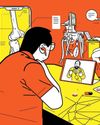A combination of telemedicine and on-the-ground presence, along with an asset-light model, are helping Gramin Healthcare scale its primary health care model in rural areas.

On a hot, humid August day in Nalvi Kalan village in Haryana’s Karnal district, a portion of a primary school is being used for a health camp. For two days before this, Seema, a nurse who is now checking a woman’s eyesight using charts suitable for the unschooled, went around the village with a megaphone, announcing the camp. Announcements were also made at the school so that children could tell their parents about it; today women and men, children in tow, are lining up to register for a health card that will give them access to primary health care all year round. A doctor and two nurses conduct various basic tests, including blood pressure, ECG and vision. Villagers can also buy ayurvedic medicines and prescription glasses at the camp.
A camp like this is the last mile in Gramin Healthcare’s model of providing primary health care in rural India which, since it was started in September 2015, has set up 110 primary health care centres in six states; one centre is for a cluster of ten villages or so. These aim to provide villagers, who would otherwise go to a local medicine man or travel to the nearest town, with institutionalised health care closer home. Twice a week, the staff head out to individual villages to hold camps, while also maintaining digital health records of all the card holders.
“People in villages have to travel to hospitals or clinics, which not only costs them money but also a day or half a day of work. It’s worse for women who depend on their husbands to take them to the doctor. This way, the women can come over themselves. The camp also makes it easier for senior citizens,” says Sonia Vohra, head of operations, Gramin Healthcare.
Denne historien er fra September 28, 2018-utgaven av Forbes India.
Start din 7-dagers gratis prøveperiode på Magzter GOLD for å få tilgang til tusenvis av utvalgte premiumhistorier og 9000+ magasiner og aviser.
Allerede abonnent ? Logg på
Denne historien er fra September 28, 2018-utgaven av Forbes India.
Start din 7-dagers gratis prøveperiode på Magzter GOLD for å få tilgang til tusenvis av utvalgte premiumhistorier og 9000+ magasiner og aviser.
Allerede abonnent? Logg på

Home-Cooked Meal Is Now Greatly Valued
The pandemic has also brought with it an improved focus on hygiene, use of technology in dining, rise of cloud kitchens and resurgence in popularity of Indian ingredients

Paytm 3.0 - Reaching Near Breakeven In Two Years
As of 2020, Vijay Shekhar Sharma’s super app for financial services had run up losses in thousands of crores. Now, as digital payments gets yet another boost courtesy Covid-19, he’s hopeful of reaching near breakeven in two years

THE PANDEMIC HAS CAUSED WOMEN GREATER LABOUR PAIN
Covid-19 has shown that women are more likely to face the brunt of job losses than men, and find fewer opportunities when they want to resume. That apart, several have to deal with increased hours of unpaid work at home and even domestic abuse

LEADERSHIP WILL BE ABOUT SEEING THE BIGGER PICTURE
Leaders must not only guard their teams first during a crisis, but also deal with stakeholders with respect and dignity. And apart from pursuing business goals, they should remain committed to our planet and the environment

PHILANTHROPY SHOULD BE HUMBLE, BUT NOT MODEST
Apart from building a flexible and resilient framework for the future, philanthropists, civil society and the government must work in tandem so that every rupee is absorbed on the ground

INTEGRATED HEALTH CARE, TECH WILL DISRUPT SECTOR
While clinical research will get a boost, having a skilled workforce and public spending on health care will be challenges in the near term

DIGITALISATION WILL HELP IN VALUE CREATION
As the pandemic brings technology and innovation to the core of business and daily life, the next decade will see about 150 million digital-first families in India

Industry 4.0: Climate Revolution?
Augmenting sustainability alongside digital capabilities is an economic, competitive and global opportunity for India’s businesses, but regulations need to reflect intent

EV Dream Still Miles Away
Electric vehicles have remained a buzzword in India for years. But not much has moved on ground due to high upfront costs, range anxiety and charging infrastructure

Living Waters
A virus has caused us to scramble for oxygen but our chokehold on the environment is slowly strangling the very waters that breathe life into us. The virus is a timely reminder: We are merely consumers, not producers of life’s breath on this planet